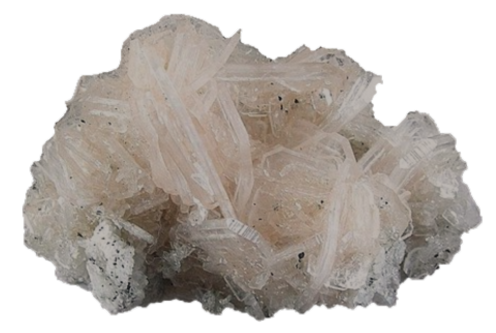
The name Apophyllite originates from the Greek words apo (meaning “off”) and phyllon (meaning “leaf”), referring to its tendency to flake apart when heated due to water loss. First identified in the 18th century, apophyllite is sometimes called fish-eye stone because of its pearly luster and transparency.
Composition, Physical Characteristics, and Varieties
Apophyllite belongs to the phyllosilicate mineral group and is composed primarily of hydrated potassium calcium fluoro-silicate. It forms in volcanic rocks and hydrothermal environments, often growing alongside zeolites. The mineral crystallises in well-formed, transparent or translucent pyramidal structures with a vitreous to pearly luster.
Varieties of apophyllite include:
- Clear Apophyllite – Colourless and highly reflective, often used in spiritual work.
- Green Apophyllite – A rarer variety, coloured by trace amounts of iron.
- Pink Apophyllite – Found in limited quantities and often associated with stilbite.
- Yellow Apophyllite – Contains vanadium or iron and has an unusual golden hue.
Geographical Locations
Apophyllite occurs in basaltic lava flows and is commonly found in India, Brazil, Canada, the United States, Scotland, Germany, and Iceland. The Deccan Traps of India are particularly renowned for producing some of the finest specimens.
Archaeological and Significant Finds with Historical and Current Usage
Historically, apophyllite has been collected for its aesthetic beauty rather than for practical applications. However, ancient cultures believed it held energetic properties that aided spiritual communication. Today, collectors and metaphysical practitioners highly prize apophyllite clusters for their unique formations and vibrational qualities.
Interesting Facts
- Apophyllite has a high water content, making it an excellent conductor of energy.
- It fluoresces under UV light, revealing different hues depending on the trace elements present.
- The mineral’s natural pyramid formations contribute to its use in energy work and meditation.
Folklore, Legends, and Tales
Many cultures associate apophyllite with divine connection and spiritual enlightenment. Some myths suggest that ancient seers and shamans used it as a scrying tool to receive visions. In Indian traditions, it is said to carry the wisdom of the gods, aiding in higher consciousness and connection with celestial realms.
Mystical Healing Properties, Astrology, and Zodiac Links
Apophyllite is often linked with clarity, intuition, and emotional healing. It is believed to:
- Reduce anxiety and promote calmness.
- Enhance spiritual awareness and connection to higher realms.
- Aid in meditation and accessing past life information.
Astrologically, apophyllite resonates with Gemini and Libra due to its airy, high-frequency energy that promotes communication and balance. It is also associated with the element of air and planetary influences of Mercury and Venus.
Chakra System
Apophyllite is primarily connected with the Third Eye and Crown Chakras. It is thought to:
- Open and activate the Crown Chakra, fostering enlightenment.
- Stimulate the Third Eye Chakra, enhancing intuition and inner vision.
- Clear energetic blockages and harmonise spiritual energies.
Use as a Birthstone and for a Wedding Anniversary
While not a traditional birthstone, apophyllite is sometimes given to those born under air signs for its alignment with intellectual and spiritual growth. It makes a meaningful gift for anniversaries, symbolising deep emotional connection and higher understanding in a relationship.
